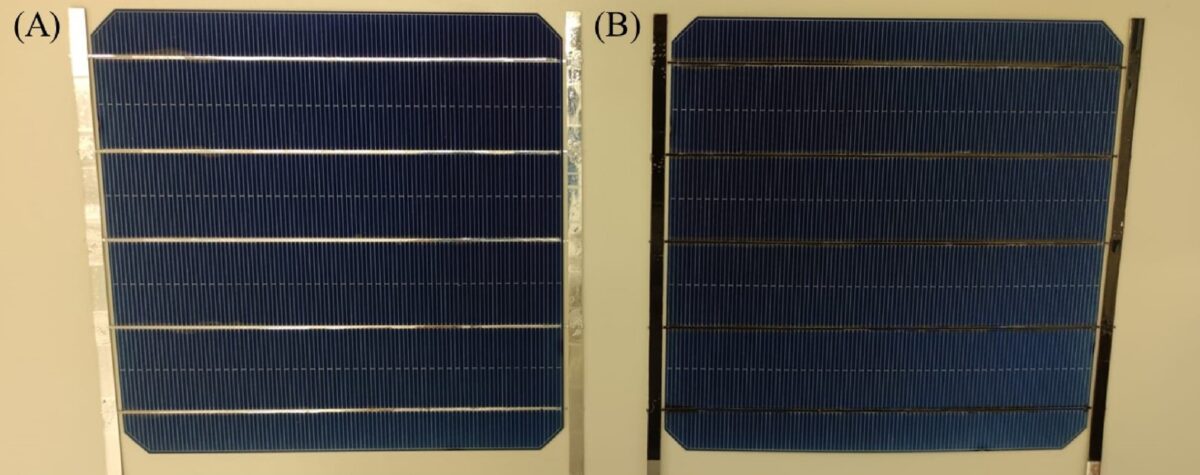A group of researchers in Switzerland has investigated the visual stability and electrical performance of black interconnect coatings used in PV modules. These coatings are utilized to improve the aesthetic appeal of building-integrated photovoltaic (BIPV) modules, as they minimize their appearance on black back sheets.
“Interconnect hiding is often achieved through expensive and inefficient manufacturing steps, such as applying colored strips or bands with manual positioning,” the researchers explained. “A possible solution to modify the appearance of the metallic ribbons is to coat them with ink. Inkjet is one of the best technologies able to cope with the requirements of accuracy, resolution, and flexibility to coat the bright metallic ribbons.”
In a conversation with pv magazine, corresponding author Dr. Alejandro Borja Block added that “the cost of the manual process could be around 3 CHF ($3.32)/module, while an automated process could be 0.15 CHF/module approximately. It’s important to consider that many suppositions are made when doing these estimations, such as the automation degree of the equipment, lifetime of the equipment, consumables cost, cost of energy used, speed of the process, etc.”
In the paper “Stability of black interconnect coatings for solar photovoltaic module applications,” published in Solar Energy Materials and Solar Cells, the research team compared three types of metallic ribbons – one was a commercially available black ribbon with no information about the coating used, while the other two were coated in the laboratory with UV-curable inkjet commercial inks.
The scientists tested the three ribbons in a sequence based on industry-standard IEC 62788-7-2. All coated ribbons were cut into 3 cm long strips and were then laminated in conventional glass-back sheet (G/BS) modules.
They then encapsulated the panels using three different encapsulants, with and without UV blockers. The three samples were left in the chamber for a total of 2,000 hours, equivalent to roughly 120 kWh/m2 doses of UVA and UVB irradiance (UVA+UVB), which corresponds to approximately two years of outdoor exposure in central Europe.
“The single most striking observation to emerge from the data comparison was that the color change only appeared on the UV curable inkjet inks, not on the commercial black ribbons,” the academics said. “Ink 1 produced the largest color change, a yellow halo in the surroundings of the coated metallic interconnects appeared. This could indicate diffusion of ink components into the encapsulant and degradation. Ink 2 produced a milder but still noticeable color change.”
Popular content
After this test, the researchers dug deeper into ink 1, as it showed the most significant color change. They did it in two ways: first, by isolating the ink and the pure molecule 2-PEA to investigate whether it played an important role in the degradation observed; second, by creating a mini solar module and then coating its ribbons with the relevant ink.
The pure component samples were aged for 24 hours and 10 days, or UVA + UVB dose of 1.5 and 15 kWh/m2, respectively. “The pure component of the ink and flush, 2-PEA, polymerized after 1.5 kWh/m2, and it turned yellow after 15 kWh/m2,” the group emphasized. “This is due to the creation of carbonyl bonds in the substance, which are related to the oxidation of the molecule under UV light. The carbonyl index rose by 22% following the UV exposure of 15 kWh/m2.”
As for the sample coated module, it was aged for 6,000 hours or UVA + UVB dose of 360 kWh/m2. “The use of the investigated unstable ink would represent an aesthetical modification of color in the long-term demonstrating a potential long-term instability, but the electrical performance would be similar to a module without coated ribbons (less than 3% power loss),” noted the team.
Concluding their research, the scientists said they “discourage the use of 2-PEA monomer for PV aesthetic applications and suggest the use of UV curable inks with aliphatic monomers, which have better non-yellowing properties, in combination with UV blocker encapsulants.” They also added that “UV blocker encapsulants help mitigate the photodegradation of 2-PEA on G/BS laminates, whereas they do not fully mitigate the degradation for the ink itself.”
The team comprises academics from the Swiss Federal Institute of Technology Lausanne, Switzerland’s CSEM, Sustainable Energy Center, Austria’s Polymer Competence Center Leoben and the Academy of Sciences of the Czech Republic.
This content is protected by copyright and may not be reused. If you want to cooperate with us and would like to reuse some of our content, please contact: editors@pv-magazine.com.


By submitting this form you agree to pv magazine using your data for the purposes of publishing your comment.
Your personal data will only be disclosed or otherwise transmitted to third parties for the purposes of spam filtering or if this is necessary for technical maintenance of the website. Any other transfer to third parties will not take place unless this is justified on the basis of applicable data protection regulations or if pv magazine is legally obliged to do so.
You may revoke this consent at any time with effect for the future, in which case your personal data will be deleted immediately. Otherwise, your data will be deleted if pv magazine has processed your request or the purpose of data storage is fulfilled.
Further information on data privacy can be found in our Data Protection Policy.